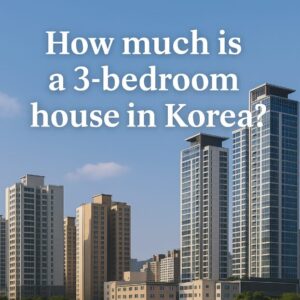Are you planning to move to South Korea with your family, or maybe considering buying a home in Seoul for the long term? Whether you’re relocating for work, looking for an investment, or just curious, one of the most common questions is: How much is a 3-bedroom house in Korea? This guide will walk you through everything you need to know — from prices to property types and regional differences — all tailored for international visitors and future residents.

Understanding the Korean Housing Market
Before diving into prices, it’s important to understand that Korea’s housing market works a bit differently than in many Western countries. Apartments are far more common than detached houses, especially in cities like Seoul and Busan. Most families live in high-rise apartment complexes, which often come with excellent amenities like security, playgrounds, and underground parking.
In Korea, there are two main options for securing a home:
Jeonse (전세): A unique Korean system where you pay a large lump-sum deposit (sometimes 50–80% of the home’s value) and live rent-free for 1–2 years.
Monthly Rent (월세): More similar to Western systems, with a smaller deposit and regular monthly payments.
This article focuses primarily on the cost to buy a 3-bedroom home, but also touches on rental options.
Price Range by Region
Prices can vary dramatically based on where in Korea you’re looking. Here’s a breakdown of major regions:
1. Seoul: The Capital Premium
Seoul is the most expensive city in Korea, and home prices reflect that. In central districts like Gangnam, Seocho, or Yongsan:
A 3-bedroom apartment (around 85–100 square meters) can cost anywhere from ₩1.3 billion to ₩2.5 billion (approximately $950,000 to $1.8 million USD).
If you’re buying a luxury unit in areas like Hannam-dong or near the Han River, prices can exceed ₩3 billion.
Outside of central districts, areas like Nowon, Eunpyeong, or Guro offer more affordable prices:
Expect around ₩600 million to ₩1.2 billion for a 3-bedroom unit depending on building age and proximity to subway stations.
2. Gyeonggi Province: Seoul’s Suburban Ring
This province surrounds Seoul and includes cities like Bundang, Ilsan, Suwon, and Yongin.
Prices for 3-bedroom homes range from ₩500 million to ₩1 billion, which is significantly cheaper than Seoul proper.
Many expats choose to live in Gyeonggi for more space and a quieter environment, while still being able to commute to Seoul in under an hour via subway or commuter trains.
3. Busan: Coastal Living with a View
As Korea’s second-largest city and a popular coastal destination, Busan offers great value for money.
In central areas like Haeundae or Suyeong-gu, expect to pay between ₩700 million to ₩1.5 billion for a 3-bedroom apartment with ocean views.
Less central areas like Sasang or Dongnae can offer options as low as ₩400 million.
4. Other Cities: Affordable and Comfortable
Cities like Daegu, Gwangju, Daejeon, and Ulsan are known for having more affordable housing. In these areas:
A 3-bedroom apartment often costs between ₩300 million to ₩600 million.
In rural areas or smaller towns, you can even find houses (not apartments) for ₩200 million to ₩400 million — a fraction of Seoul prices.
Rental Prices for 3-Bedroom Homes
If you’re not ready to buy, here’s a general idea of what to expect for monthly rentals:
Seoul City Center: ₩2.5 million to ₩6 million/month
Seoul Suburbs: ₩1.5 million to ₩2.5 million/month
Busan City Center: ₩1.2 million to ₩2 million/month
Other Cities: ₩800,000 to ₩1.5 million/month
Keep in mind, many landlords require at least a ₩10 million deposit for rentals — higher in luxury properties.
What Do You Get for the Price?
A typical 3-bedroom apartment in Korea will have:
2 bathrooms
An open kitchen and living room
Underfloor heating (called ondol, a Korean standard)
Balconies for laundry or small plants
Elevator and security system (if in an apartment building)
Parking (often included in newer buildings)
Luxury complexes like Raemian, Hillstate, and IPARK may include community gyms, libraries, golf simulators, and concierge services.
If you’re buying a standalone house (more common outside of Seoul), you might get a yard, garden, and more square footage — but you’ll likely need a car and maintenance costs can be higher.
Things Foreign Buyers Should Know
Can foreigners buy property in Korea?
Yes. Foreigners can legally purchase real estate in Korea without Korean citizenship. However, you will need a Foreigner Registration Number and to report the purchase within 60 days.Mortgage availability
Mortgages are available for foreigners, but they often require a Korean guarantor or significant documentation. Interest rates typically range from 3–5% as of 2025.Real estate agents
Work with a bilingual agent who is familiar with foreign clients. Agencies like Ziptoss or Realty Korea cater specifically to expats.Extra costs
Be prepared to pay a 1–3% transaction tax, legal fees, and monthly maintenance fees (usually ₩200,000–₩500,000).
Best Platforms to Start Your Search
Ready to look? Here are a few user-friendly platforms for English speakers:
Ziptoss.com – Apartments and shared housing for expats
SeoulHomes.kr – Purchase and long-term rentals
PeterPanHouse.com – Great for locals and foreigners alike
Craigslist Seoul – Hit or miss, but still used by some landlords
Final Tips for Finding Your Ideal Korean Home
Korea’s housing market can seem overwhelming at first, especially with cultural differences and unique systems like jeonse. But with proper planning and the right support, finding a spacious, comfortable 3-bedroom home is absolutely achievable.
If you’re moving with a family, prioritize neighborhoods near international schools, parks, and transportation. Areas like Hannam-dong, Seorae Village, or Bundang are especially foreigner-friendly.
And if you’re still comparing neighborhoods or wondering where to begin, check out our full guide on where to live in Seoul as an expat.